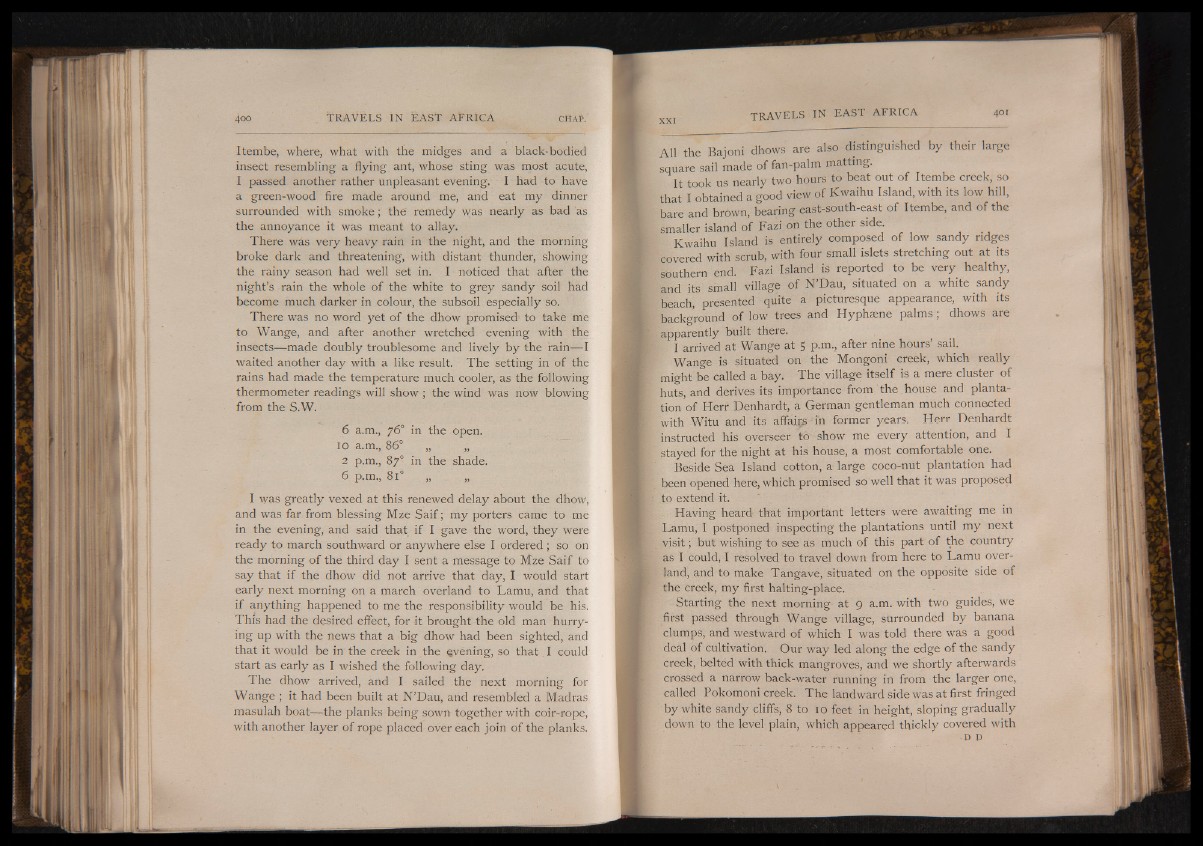
Itembe, where, what with the midges and a black-bodied
insect resembling a flying ant, whose sting was most acute,
I passed another rather unpleasant evening. I had to have
a green-wood fire made around me, and eat my dinner
surrounded with smoke; the remedy was nearly as bad as
the annoyance it was meant to allay.
There was very heavy rain in the night, and the morning
broke dark and threatening, with distant thunder, showing
the rainy season had well set in. I noticed that after the
night’s rain the whole of the white to grey sandy soil had
become much darker in colour, the subsoil especially so.
There was no word yet of the dhow promised to take me
to Wange, and after another wretched evening with the
insects— made doubly troublesome and lively by the rain— I
waited another day with a like result. The setting in of the
rains had made the temperature much cooler, as the following
thermometer readings will show ; the wind was now blowing
from the S.W.
6 a.m., 76° in the open.
10 a.m., 86° „ „
2 p.m., 87° in the shade.
6 p.m., 8i° „ , „
I was greatly vexed at this renewed delay about the dhow,
and was far from blessing Mze S a if; my porters came to me
in the evening, and said that if I gave the word, they were
ready to march southward or anywhere else I ordered; so on
the morning of the third day I sent a message to Mze Saif to
say that if the dhow did not arrive that day, I would start
early next morning on a march overland to Lamu, and that
if anything happened to me the responsibility would be his.
This had the desired effect, for it brought the old man hurrying
up with the news that a big dhow had been sighted, and
that it would be in the creek in the evening, so tha t. I could
start as early as I wished the following day.
The dhow arrived, and I sailed the next morning for
Wange; it had been built at N’Dau, and resembled a Madras
masulah boat— the planks being sown together with coir-rope,
with another layer of rope placed over each join of the planks.
All the Bajoni dhows are also distinguished by their large
square sail made of fan-palm matting.
It took us nearly two hours to beat out of Itembe creek, so
that I obtained a good view of Kwaihu Island, with its low hill,
bare and brown, bearing east-south-east of Itembe, and of the
smaller island of Fazi on the other side.
Kwaihu Island is entirely composed of low sandy ridges
covered with scrub, with four small islets stretching out at its
southern end. Fazi Island is reported to be very healthy,
and its small village of N’Dau, situated on a white sandy
beach, presented quite a picturesque appearance, with its
background of low trees and Hyphsene palms; dhows are
apparently built there.
I arrived at Wange at 5 p.m., after nine hours’ sail.
Wange is situated on the Mongoni creek, which really
might be called a bay. The village itself is a mere cluster of
huts, and derives its importance from the house and plantation
of Herr Denhardt, a German gentleman much connected
with Witu and its affairs in former years. Herr Denhardt
instructed his overseer to show me every attention, and I
stayed for the night at his house, a most comfortable one.
Beside Sea Island cotton, a large coco-nut plantation had
been opened here, which promised so well that it was proposed
to extend it.
Having heard that important letters were awaiting me in
Lamu, I postponed inspecting the plantations until my next
visit; but wishing to see as much of this part of the country
as I could, I resolved to travel down from here to Lamu overland,
and to make Tangave, situated on the opposite side of
the creek, my first halting-place.
Starting the next morning at 9 a.m. with two guides, we
first passed through Wange village, surrounded by banana
clumps, and westward of which I was told there was a good
deal of cultivation. Our way led along the edge of the sandy
creek, belted with thick mangroves, and we shortly afterwards
crossed a narrow back-water running in from the larger one,
called Pokomoni creek. The landward side was at first fringed
by white sandy cliffs, 8 to 10 feet in height, sloping gradually
down to the level plain, which appeared thickly covered with
P P